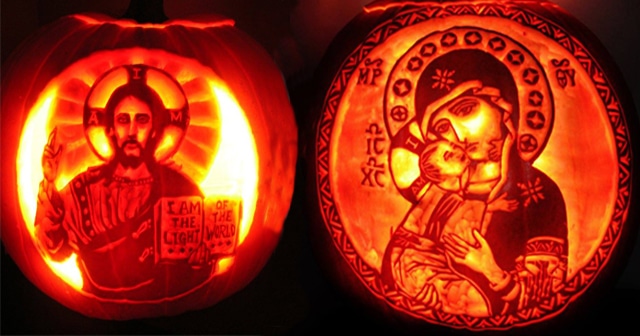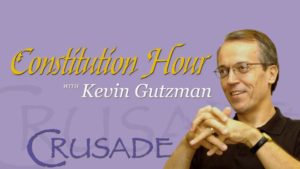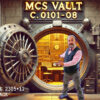In the West, Pope Boniface IV. instituted, in 610, a “festum omnium Sanctorum” for the Pantheon, which the Emperor Phocas had presented to the Holy See, and which was transformed into a church of the most blessed Virgin and of all the martyrs. But this festival (on November 1st), was not generally observed till the ninth century. The large number of canonised saints rendered it possible to dedicate every day in the calendar to one or more saints. Generally, the anniversary of their death was selected for that purpose; in the case of John the Baptist alone an exception was made in favour of his birth-day (natalis S. Joannis). – [emphasis mine- M C]
The Ghouls of Halloween Actually Are Defeated Ghouls!
Now comes the best part of the story and like most urban-legend smashing ventures, contains some delicious irony. This irony is so precise and of such relevance it is impossible to dismiss the great Invisible Hand of the Paraclete at work. That Halloween has become a costumed exercise populated by ugliness read antithesis of beauty, it is only fitting that the Christian should revel in the defeat of demons actually on display. For insight to this we turn to the 4th century golden tongued Doctor of the Church, St John Chrysostom; Chrysostomos in Greek is “golden mouth”. The learned 18th century Church historian Joseph Bingham recounts an ancient text of Chrysostom’s Homily on the Pentacost and feast of Martyrs.
“The devil,” says he, “introduced death into the world, but the wisdom of God turned it to our honour and glory; for hereby he opened the way to martyrdom, and made our destruction become the occasion of a crown. The devil designed to ruin us by death, but Christ inverted his design, and makes use of death to introduce us into Heaven by martyrdom. Here, as in all other battles, there were armies engaged on both sides, the martyrs on the one side, and tyrants on the other. The tyrants were armed, and the martyrs naked; yet, they that were naked got the victory, and they that carried arms were vanquished. What an astonishing engagement was this? He that is beaten, proves victor over him that beats him; he that is bound, overcomes him that is at liberty; he that is burnt, tames him that burns him; and he that dies, vanquishes him that puts him to death. These are astonishing things: but it is grace that works these miracles; they are above the strength of nature.” Thus the Ancients extolled their martyrs, those heroes of Christianity, by just praises and commendations, and endeavoured to provoke others to piety and virtue by their example, which was the great end and design of these holy solemnities and frequent meetings at the memorials of the martyrs. [emphasis mine- M C]
We can glean from St John, here, that costuming as a martyr is the greatest smackdown one could deliver to the ghouls parading about the earth in search of the ruin of souls and their mortal imitators in search of the ruin of their teeth through the Mars Candy company.
The Great Pumpkin Is Actually A Catholic Church


In his book Halloween: Hallowed Is Thy Name, author Eddie Smith relates:
“It has been noted that being inside the awe-inspiring Pantheon feels almost like one is standing inside a gigantic pumpkin.”
We noted above that the feast of All Martyrs was begun with a precession of Saint relics that were deposited inside the Pantheon after its conversion to a Catholic Church in honor of the Blessed Virgin. This may not provide a direct link to “The Great Pumpkin” story but it does add to the sacred origins of Halloween. Wait, did I just write “scared” Halloween? Yes and there is good reason for this as we shall see. Turning to the author and historian of the tutorfidelis blog, who humbly remains anonymous, we learn the history of the name Halloween.
October 31st itself held no special significance in the Church calendar until 1484 (again, long, long past the time of the Druids) when Pope Sixtus IV declared the “Feast of All Saints” a holy day of obligation (days on which Catholics are obligated to attend Mass – in addition to Sundays) and gave it a vigil and an eight-day period or octave to celebrate the feast (the octave of All Saints was removed from the Church calendar in 1955). For Catholics, the vigil is celebrated on the evening before the feast – hence Christmas Eve. Saints were known as “hallowed” in old English. Therefore, the vigil for the Feast of All Saints, or “All Hallows,” became known as “All Hallows’ Eve” – Halloween.
Finally, let’s close our pre-Halloween festivities with the fact that there is no evidence whatsoever that Halloween, regardless of what name it was called by various Europeans, was not a “holiday” stolen by “marauding Catholics” from innocent, humble Druids; from Tutorfidelis:
 The fact that “Halloween” is derived from old English and the Druids happened to inhabit ancient Britain is as close as we come to a direct connection between the Catholic Church, Druids and today’s Halloween.
The fact that “Halloween” is derived from old English and the Druids happened to inhabit ancient Britain is as close as we come to a direct connection between the Catholic Church, Druids and today’s Halloween.
I hope this essay helps to squash the usual, anti-Catholic bigotry that gets trotted out at the end of every October and puts you at ease to dress the kids up in appropriate Halloween attire, here are some suggestions, with the gory, albeit crowned with Martyrdom details by the Rev. Alban Butler.
St Lucy – St. Lucy is often painted with the balls of her eyes laid in a dish: perhaps her eyes were defaced or plucked out, though her present acts make no mention of any such circumstance. In many places her intercession is particularly implored for distempers of the eyes.
St Vincent of Saragossa – The saint walked with joy to the frightful engine, so as almost to get the start of his executioners, such was his desire to suffer. He mounted cheerfully the iron bed, in which the bars were framed like scythes, full of sharp spikes made red-hot by the fire underneath. On this dreadful gridiron the martyr was stretched out at length, and bound fast down. He was not only scourged thereon; but, while one part of his body was broiling next the fire, the other was tortured by the application of red-hot plates of iron. His wounds were rubbed with salt, which the activity of the fire forced the deeper into his flesh and bowels. All the parts of his body were tormented in this manner, one after the other, and each several times over. The melted fat dropping from the flesh nourished and increased the flames; which, instead of tormenting, seemed, as St. Austin says, to give the martyr new vigour and courage; for the more he suffered, the greater seemed to be the inward joy and consolation of his soul.















Giacomo on October 31, 2015
The more one learns the more one realizes just how much there is to learn…kudos Mr. Church and thank you for all you do.